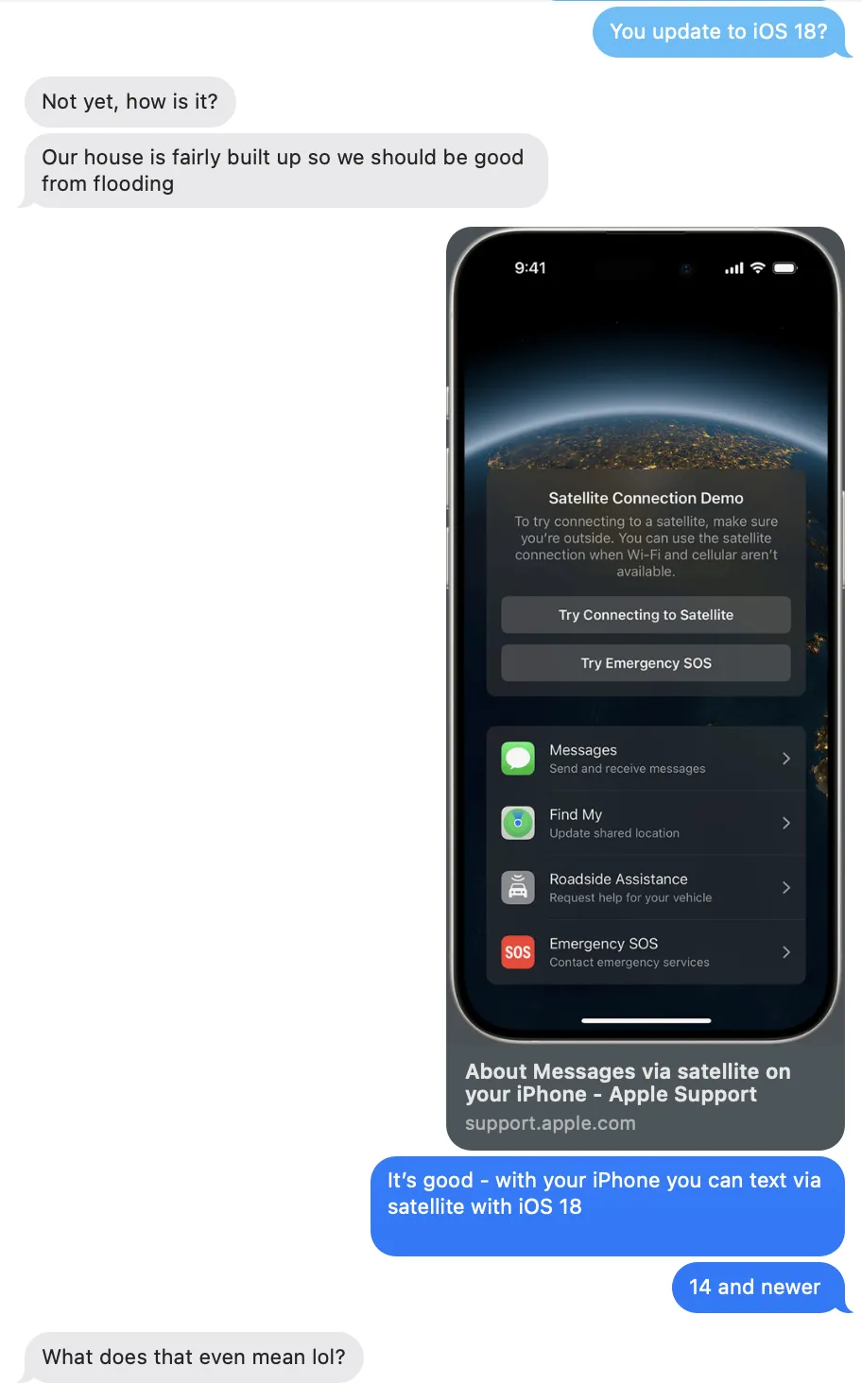Forever Connected
⏲ 4-minute read
In recent years, Apple casually rolled out global satellite connectivity for iPhones when cell coverage is unavailable. It began with an announcement during the iPhone 14 keynote in 2022, with Ashley Williams from the Satellite Connectivity Group. Here’s her segment from that keynote:
Apple's Satellite Connectivity History
At launch, Satellite service was only available for emergencies, which turned out to be a tremendous help during the Maui wildfires of 2023. Later that year, Apple extended the service to include emergency roadside assistance, and this past year with iOS 18, added standard (non-emergency) iMessage/SMS over satellite.
Which is how, with a software update, owners of an iPhone 14 and newer were quietly gifted global connectivity, for free. So quietly, in fact, when I let some Florida friends know about the feature during hurricane Milton this year, their response was confusion.

The Present Moment
We're at the precipice of a connectivity paradigm shift.
Satellite internet has proven to be incredibly valuable. Internet from space is tricky to block. Delivery doesn't require right-of-way disputes or buried cables, making it profitable to deliver to remote communities. It's why major cell carriers (and others) are racing towards this: T-Mobile and Starlink, Verizon and Skylo, and AT&T and AST SpaceMobile all have partnerships to offer satellite cell coverage. While Qualcomm's partnership with Iridium fell through, they still added the necessary hardware for Android phones with the Snapdragon 8 Gen 2 (provided the antenna is included by the device manufacturer).
For the iPhone and Apple, all this is currently enabled by Globalstar, a company who has purportedly reserved ~85% of its network for Apple. As of a few months ago, Apple also announced $1.7B in investment and 20% stake in the company1.
Apple's Master Plan
As satellite technology matures, I suspect we'll see Apple roll satellite services into existing iCloud+ subscriptions. A "Satellite as a Service" offering, - essentially the new SaaS - while keeping emergency S.O.S services free2.
Who will say no to global connectivity for an extra dollar or two per month? It seems like a no-brainer. Wall Street will love the added revenue from these subscription fees, and Apple’s control over both hardware and software gives them a strong position to execute this seamlessly. Google (and Android) will catch up, but Apple has at least a two-year head start.
A Perpetually Connected Life
Today, with an iPhone 14 or newer on the latest OS, you already have global texting3. This is real, right now. Over the next few years as Satellite technology matures, spectrum is released4, and competition heats up, I expect Apple will expand its service to include light web browsing and limited low-bandwidth apps (ones that don't stream video or audio).
So what does it mean to live in a world perpetually connected?.
For starters, the term “off-grid” will lose its meaning5. The internet will officially be everywhere. Sure, we can mindfully disconnect by leaving our devices behind or turning them off completely, but history shows this to be a failing proposition. No, when we have ability to stay connected, we will because it brings us comfort.
Over time, we'll come to expect ubiquitous satellite coverage in much the same way we currently expect LTE and 5G. Between existing terrestrial networks, satellite partnerships, and built-in hardware capabilities, dead-zones will become a foreign concept. We may not know how we're connecting, only that we're connected.
Connection
The irony is that the absence of connectivity so often fosters deeper connection—with ourselves, others, and the world. As Kōdō Shimon, an author whose ideas increasingly resonate with my own, said:
We've optimized away discomfort, only to find that it was a secret ingredient.
Perhaps that’s the point—to keep us connected. As the final frontiers of human solitude—remote forests, mountain peaks, open oceans—lose their refuge from the world’s ceaseless hum, it will be for our safety, our convenience, and our entertainment. And as these final bastions of reclusion are driven to extinction, it will be met by most with fanfare and jubilation, by some with melancholy and nostalgia, and by only a few with the question: “What have we lost?”
Interestingly, most the Satellites are being launched by SpaceX, who is also competing to offer satellite connectivity directly. Man it would be great to invest in SpaceX.↩
It's a bad look to require a subscription to call for help if the phone can technically do it already, and it's probably required by law anyway.↩
For those who are paying attention, this isn't technically true, you actually have coverage everywhere south of approximately 62° latitude.↩
From the FT on how spectrum works: "So every three to four years, the ITU brings spectrum regulators from more than 190 nations together with industry at the World Radiocommunication Conference to review and, if necessary, revise the Radio Regulations, an international treaty governing the use of the radio-frequency spectrum and orbits. It is there that agreement is reached on which bands will be used for which purposes. But ITU member states still have ultimate sovereignty in deciding how to allocate and regulate spectrum within their own borders. They can set the terms and conditions of operation domestically."↩
Seriously, they're building this tech into everything - next year, even the new Apple Watch Ultra is gonna get it.↩